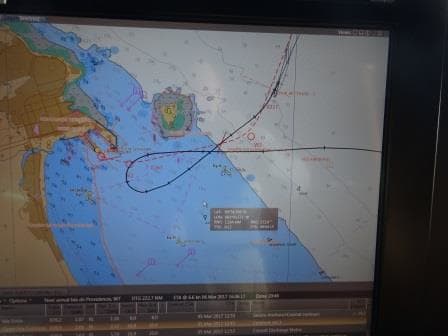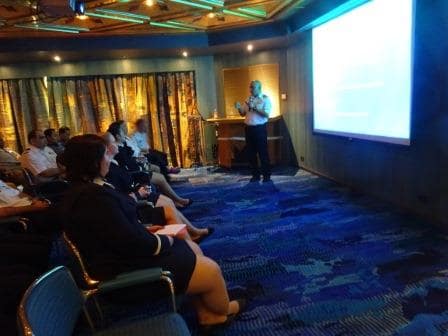We had a bit of a bumpy night while sailing from Panama to Costa Rico, courtesy of high waves which were just under the wrong angle for the stabilizers to deal with. That gave me a bad foreboding about the call at Puerto Limon as the angle which I observed rolls freely into the port and is nowhere stopped by a breakwater or anything. But you still have to go there and observe the situation, consult the pilot and then make a decision. So by 06.00 the captain was looking at the swell rolling in, the waves smashing against the rocks and listening to the pilot who advised that the waves at the dock were going 5 feet up and down every 15 seconds.
That would mean that the ship was going to do that as well and apart from that, would also possibly be rolling. You cannot stay safely alongside the dock like that and certainly not have a gangway out. We could see that all the docks were empty and all the ships were sitting at anchor. Yesterday one of the cargo ships had broken all her moorings and a Princess Cruise ship had also sailed on after a good look at the situation. Yesterday was bad, today was not any better and tomorrow was also doubtful. So the only thing that could be done, abort the approach and cancel the call.

Point of no return. The red circle right under the black course line is the last moment you can still turn away without doing something drastic.
When we plan an approach to a port, there is always an abort point in the planning: also called a commitment point. This is the last moment you can turn safely away from the port without having to do anything drastic. Thus a captain will make a decision about going in, before the ship reaches this abort point. And when it does, it has been calculated with how much speed and how much rudder angle the ship can safely turn away. Today we used that exact point and while the captain was calling Fleet Operations, the Staff Captain sailed the ship back out again along the planned line.
The problem with Puerto Limon is that there are no other ports in the direct vicinity which would work as an alternative. All the nearest ports would need at least half a day steaming and then the port time left would be too short. In area’s such as the Mediterranean you often can just go to the other side of an island, or to a town at the other side of a mountain and you are back in business. Unfortunately nothing like that works in this area.
Puerto Limon is also the last port of this cruise and thus we now have 3 days at sea. The good thing is that we can sail a little bit slower now as we have more time to make Ft. Lauderdale. With the swell and the wind out there, a slower speed helps to make the ship ride a bit more comfortable. I expect that we will keep theses unpleasant seas until we are a bit higher up in the North West Caribbean and the 30+ knots winds might return to something of a standard Trade Wind.

Doctor Socrates explaining to all of us how the procedures work if you have too many injured people on board and only a few medical staff.
Thus the Guests were offered an alternative daily program and the crew had to deal with a full sea day instead of a port day, where during the day at least half of the guests are gone. For port days we always have a lot of training planned as it does not affect the service for the guests and a suddenly port call cancellation means a lot of re-arranging. With the world getting so complex everybody is involved in giving training and passing on information. Lately we even had the ships doctor in front of the officers to explain the latest procedures in the companies Mass Casualty Program. (More about that next cruise) The doctor’s name is Socrates Garcia and I asked him why his name was not Hippocrates. Well it turned out that his parents were teachers and were hoping for him to become a teacher as well, hence Socrates. But maybe the Doctor will get it right with his next generation.
So we are looking forward to two more days at sea. Tomorrow we should have a frontal system coming over with a bit of rain and then we have to see what the balance between the weather systems on the American continent do, what will come from the North Atlantic Ocean and how strong the Trade wind is going to be. Those three items will dictate the weather we will have in Ft. Lauderdale on Wednesday.

Leave a Reply